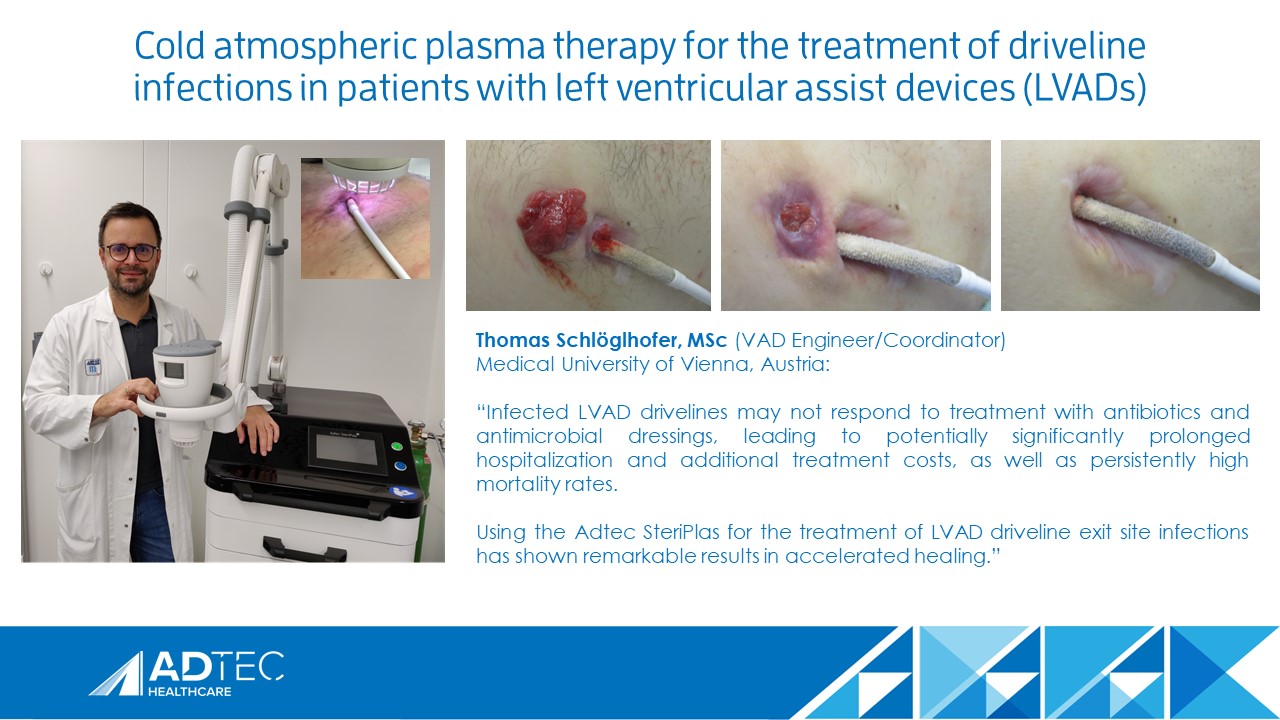Adtec Healthcare Ltd to showcase at the LSX Conference in London
We’re on a mission to revolutionize the global wound care market! Adtec Healthcare is participating in the LSX Conference in London.
Our managing director, Mary McGovern shall present our cold plasma technology at the MedTech Showcase on Thursday 4th May at 11:30 am.
We have developed SteriPlas, a medical device for the treatment of chronic wounds. The most effective cold plasma technology for wound care treatment, proven by clinical studies. The device uses proven antibacterial cold atmospheric argon plasma to treat chronic wounds, dermatology, and post-operative wound infections. Enables faster healing, reduces hospital stays, eliminates biofilms and the use of antibiotics. CE Marked and available for sale in UK and EU. Efficacy proven in 70+ peer-reviewed clinical studies. Early adoption by leading wound care specialists. Strong IP portfolio, comprising of granted and recently submitted patents covering various aspects of their device.
We are currently speaking to investors to accelerate sales in Europe and for the launch in the US. At LSX, we are meeting investors and partners interested in medical devices and wound care.
Please contact us at info@adtecplasma.com to arrange a meeting.
https://www.lsxleaders.com/lsx-world-congress/agenda/medtech

Thomas presents at the ISHLT show
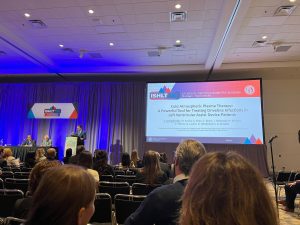
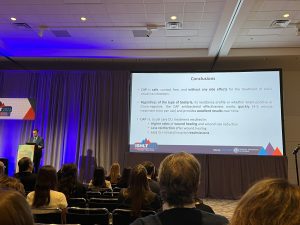
A fantastic presentation delivered by Thomas Schlöglhofer yesterday at the ISHLT - International Society for Heart and Lung Transplantation show. We hope you got the chance to see his presentation and the promising results he has achieved managing LVAD infections with our Cold Plasma SteriPlas medical device. If you are interested to learn more about the SteriPlas and the benefits it can bring to your patients, please contact us at info@adtecplasma.com
A great start to the ISHLT show

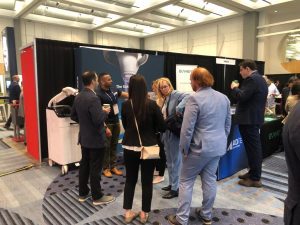
What a fantastic start to the International Society For Heart and Lung Transplantation! We’ve been swamped with your presence and interest. It’s been a pleasure to meet new and old faces and we’ve been excited to share how well our leading Cold Plasma SteriPlas medical device is changing lives in the UK and Europe for LVAD patients.
We look forward to welcoming you to our booth no.416 ready to introduce you to the strong benefits of our Cold Plasma efficacy.
Cold Plasma Walk at ISHLT
We’re excited to be exhibiting at the ISHLT conference next week and we look forward to supporting Mr Thomas Schlöglhofer as he presents his SteriPlas Cold Plasma presentation for the management of LVAD infections during the “Bugs, Drugs, and Thugs: Fighting Infection in VADs Any Way We Can” session on Wednesday 19th April between 5:30 PM - 6:30 PM.
Due to popular demand, we will be hosting a Cold Plasma Walk session at our exhibition booth on Wednesday 19th April during the lunch break. We encourage you to visit our booth no. 416 so you can see Thomas present our medical device and explain the strong benefits it can bring to the management of LVAD infections.
Our proven and patented Cold Plasma medical device has been widely adopted as the solution for LVAD infections due to its unique physical mode of action, quick treatment times and accelerated healing with stalled infections due to biofilm all whilst protecting the patient and user from no side effects.
Contact us at info@adtecplasma.com for more information.

Day 2 of the SCTS
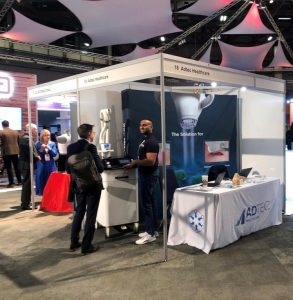
It's Day 2 of the Society for Cardiothoracic Surgery in GB & Ireland (SCTS) conference and we've been overwhelmed with all your interest in our Cold Plasma medical device, the SteriPlas. Visit us at booth 18 to learn more about how to bring the benefits of our medical device to your hospital.
How does the Adtec SteriPlas work so effectively?
Our patented cold plasma therapy utilises a physical mode of action approach delivered from an indirect microwave plasma source. Our cold argon plasma is an electrically charged and ionised gas that consists of charged particles, UV light and reactive oxygen and nitrogen species with the latter created as a by-product. They all work collectively to physically rupture the structure of bacteria even if they are protected within biofilm. Regardless of the type of bacteria, its resistance profile or whether they are Gram-positive or Gram-negative our cold plasma works quickly and effectively to destroy them. This has the leading advantage over conventional therapies such as antibiotics that rely on a chemical mode of action approach.
Although antibiotics have been a pivotal part of today’s medicine, they also contribute towards antimicrobial resistance rates particularly because bacteria can develop resistance such as those observed with diabetic foot ulcers that can often lead to amputations as a result.
However, as well as being fast-acting and effective, our cold plasma has shown that a primary or secondary resistance is unlikely to be developed due to its physical mode of action.
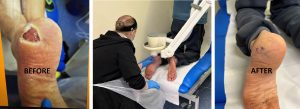
Mr Schlöglhofer to present SteriPlas at the ISHLT
Congratulations to Thomas Schlöglhofer from the Medical University of Vienna for his continued success of using our medical device to treat infections in LVAD patients. He will be presenting at The International Society for Heart and Lung Transplantation (ISHLT) conference in April to deliver the great results he has so far achieved.
His presentation, “Cold Atmospheric Plasma Therapy: A Powerful Tool for Treating Driveline Infections in Left Ventricular Assist Device Patients” will be during the “Bugs, Drugs, and Thugs: Fighting Infection in VADs Any Way We Can” Session on Wednesday 19th April between 5:30 PM - 6:30 PM.
We hope you will be there too to see him deliver his promising results.
For more information on how our medical device is fighting against multi resistant bacteria and biofilm in LVAD patients.

Can two plasma medical devices have the same clinical efficacy?
We have been asked by Health Care Professionals to clarify , “What is the difference between the Adtec SteriPlas (Adtec Healthcare) and other cold plasma technologies such as Plasma Care® ?” or “Can two different plasma technologies have the same clinical efficacy… what’s the difference?”.
The answers to these questions are that there is a significant difference between plasma technologies, and it is therefore not possible to claim a similarity in clinical efficacy as the plasma treatments would be different.
Two devices do not produce the same plasma and it is the composition of the plasma that exerts the effects, beneficial and detrimental. For the importance of patient safety, Adtec Healthcare advises against any other plasma device claiming clinical efficacy from the clinical evidence of the CE approved SteriPlas gas plasma. Adtec’s clinical data should never be used to compare to any other plasma treatment which have not yet been clinically tested.
Atmospheric pressure Plasma has a myriad of potential medical applications from low energy plasmas used for wound healing to higher energy plasmas used to cut bones during an operation or for coagulation. The main differences in all plasma technologies include the different forms of plasmas electrode source designs, types of energy used (RF, DC and microwave) and gas used (argon, helium or nitrogen etc) versus air. The Adtec SteriPlas (MicroPlaSter) plasma technology is based on a microwave powered plasma jet utilising argon gas and the other technology is a DC powered Surface Micro Discharge (SMD) plasma source utilising air as carrier gas. The type of plasma generated corresponds directly to the type of treatment delivered to the patient. Each type of plasma delivers a specific type of treatment.
During the pre-clinical trials and studies, Max Planck had conducted a study illustrating the noticeable differences of our argon gas microwave plasma treatment vs the surface micro-discharge (SMD) ‘Air plasma’ treatment developed at MPI. In this study, clear distinctions could be observed such as argon gas plasma treatment included predictable, safe and low dosages of reactive species whereas air-based plasmas would deliver significantly higher concentrations (over 37 times more than argon microwave plasma). Air Plasma has much higher levels of NOx and Ozone than argon gas plasma and needs to be tested not only clinically but also safety for the operator. It is essential to verify the product safety and clinical safety of these higher levels of NOx. The air-based plasmas are also generally dependent on the surrounding environment; temperature and humidity will affect the way the plasmas are generated and therefore difficult to deliver the same treatment each time the plasma is generated.

Adtec Plasma Technology has been at the forefront for the development of plasma products for over 30 years, proudly placing us as one of the leaders in the semiconductor and RF plasma market. Adtec has also developed other plasma technologies (gas and air) for remote plasma, gas abatement and surface treatment applications.
In 2002, we designed our first cold plasma technology showing painless effect on contact with human skin. This revolutionised the way how we are used to dealing with plasmas – typically sought as too hot to touch but now redesigned to be colder and harmless on contact with skin. In 2004, our research results were presented at a plasma conference showing distinctive microbial load reduction was possible when bacteria were exposed to our gas plasma.
Later in 2004, Adtec introduced this plasma technology to the Max Planck Institute for Extraterrestrial Physics leading to a collaboration in plasma medicine. The Adtec plasma source was adapted to a wide area plasma source in collaboration with MPI. This plasma source of the medical device is a shared patent with Adtec and MPI (as seen in the image below). This plasma source is one of the critical components used in the SteriPlas and MicroPlaSter. Adtec solely and exclusively designed and developed the medical device prototypes and products including customized components, electrical, mechanical and software program satisfying the strict standards of European medical device regulations.


We are grateful to the plasma medicine team at Max Planck for having an interest in our plasma technology system, for carrying out extensive scientific research and for managing the clinical trials using the Adtec MicroPlaSter. These clinical trials placed our medical device as the first worldwide to be used in clinical trials on wounds, paving a new treatment programme that would later be adopted by other companies with an interest to develop gas plasma medical devices. The extensive research and clinical testing assure us of the safety of the product and the technology.
The new European MDR regulations coming into force next year also require all companies to produce proper clinical evidence to support their product claims. We do emphasize the importance of proper pre-clinical and clinical testing of all types of plasma technologies in order to be assured of the product and clinical safety. Adtec Healthcare do encourage and support plasma companies in this industry as our goal is to make gas plasma a recognised treatment option for patients with wounds, surgical site infections and dermatological conditions.



